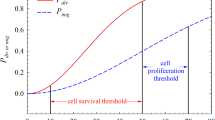Abstract
Angiogenesis is a key process in the tumoral growth which allows the cancerous tissue to impact on its vasculature in order to improve the nutrient’s supply and the metastatic process. In this paper, we introduce a model for the density of metastasis which takes into account for this feature. It is a two-dimensional structured population equation with a vanishing velocity field and a source term on the boundary. We present here the mathematical analysis of the model, namely the well-posedness of the equation and the asymptotic behavior of the solutions, whose natural regularity led us to investigate some basic properties of the space \({W_{\rm div}(\Omega)=\left\{V\in L^1;\;{\rm div}(GV)\in L^1\right\}}\), where G is the velocity field of the equation.
Similar content being viewed by others
References
Adimy M., Crauste F.: Un modèle non-linéaire de prolifération cellulaire: extinction des cellules et invariance. C. R. Math. Acad. Sci. Paris 336(7), 559–564 (2003)
H. T. Banks and F. Kappel. Transformation semigroups and L 1-approximation for size structured population models. Semigroup Forum, 38(2):141–155, 1989. Semigroups and differential operators (Oberwolfach, 1988).
Barbolosi D., Benabdallah A., Hubert F., Verga F.: Mathematical and numerical analysis for a model of growing metastatic tumors. Math. Biosci. 218(1), 1–14 (2009)
Bardos C.: Problèmes aux limites pour les équations aux dérivées partielles du premier ordre à coefficients réels; théorèmes d’approximation; application à l’équation de transport. Ann. Sci. École Norm. Sup. 4 3, 185–233 (1970)
Billy F., Ribba B., Saut O., Morre-Trouilhet H., Colin T., Bresch D., Boissel J-P., Grenier E., Flandrois J-P.: A pharmacologically based multiscale mathematical model of angiogenesis and its use in investigating the efficacy of a new cancer treatment strategy. J. Theor. Biol. 260(4), 545–562 (2009)
Cessenat M.: Théorèmes de trace L p pour des espaces de fonctions de la neutronique. C. R. Acad. Sci. Paris Sér. I Math. 299(16), 831–834 (1984)
Cessenat M.: Théorèmes de trace pour des espaces de fonctions de la neutronique. C. R. Acad. Sci. Paris Sér. I Math. 300(3), 89–92 (1985)
J-P. Demailly. Numerical analysis and differential equations. (Analyse numérique et équations différentielles.) Nouvelle éd. Grenoble: Presses Univ. de Grenoble. 309 p., 1996.
A. Devys, T. Goudon, and P. Laffitte. A model describing the growth and the size distribution of multiple metastatic tumors. Discret. and contin. dyn. syst. series B, 12(4), 2009.
d’Onofrio A., Gandolfi A.(2004) Tumour eradication by antiangiogenic therapy: analysis and extensions of the model by Hahnfeldt et al (1999). Math. Biosci. 191(2):159–184
Doumic M.: Analysis of a population model structured by the cells molecular content. Math. Model. Nat. Phenom. 2(3), 121–152 (2007)
J. Droniou. Quelques résultats sur les espaces de sobolev. http://www-gm3.univ-mrs.fr/polys/, 2001.
Ebos J.M.L., Lee C.R., Crus-Munoz W., Bjarnason G.A., Christensen J.G.: Accelerated metastasis after short-term treatment with a potent inhibitor of tumor angiogenesis. Cancer Cell, 15, 232–239 (2009)
Echenim N., Monniaux D., Sorine M., Clément F.: Multi-scale modeling of the follicle selection process in the ovary. Math. Biosci., 198(1), 57–79 (2005)
K-J Engel and R. Nagel. One-parameter semigroups for linear evolution equations, volume 194 of Graduate Texts in Mathematics. Springer-Verlag, New York, 2000. With contributions by S. Brendle, M. Campiti, T. Hahn, G. Metafune, G. Nickel, D. Pallara, C. Perazzoli, A. Rhandi, S. Romanelli and R. Schnaubelt.
Hahnfeldt P., Panigraphy D., Folkman J., Hlatky L.: Tumor development under angiogenic signaling : a dynamical theory of tumor growth, treatment, response and postvascular dormancy. Cancer Research, 59, 4770–4775 (1999)
Iwata K., Kawasaki K., Shigesada N.: A dynamical model for the growth and size distribution of multiple metastatic tumors. J. Theor. Biol., 203, 177–186 (2000)
McKendrick A.G.: Applications of mathematics to medical problems. Proc. Edin. Math. Soc., 44, 98–130 (1926)
Michel P., Mischler S., Perthame B.: General relative entropy inequality: an illustration on growth models. J. Math. Pures Appl. (9) 84(9), 1235–1260 (2005)
B. Perthame. Transport equations in biology. Frontiers in Mathematics. Birkhäuser Verlag, Basel, 2007.
B. Perthame and S. K. Tumuluri. Nonlinear renewal equations. In Selected topics in cancer modeling, Model. Simul. Sci. Eng. Technol., pages 65–96. Birkhäuser Boston, Boston, MA, 2008.
Ribba B., Saut O., Colin T., Bresch D., Grenier E., Boissel J.P.: A multiscale mathematical model of avascular tumor growth to investigate the therapeutic benefit of anti-invasive agents. J. Theor. Biol., 243(4), 532–541 (2006)
Serrin J., Varberg D.E.: A general chain rule for derivatives and the change of variables formula for the Lebesgue integral. Amer. Math. Monthly, 76, 514–520 (1969)
Sharpe F.R., Lotka F.R.: A problem in age distribution. Phil. Mag. 21, 435–438 (1911)
L. Tartar. An introduction to Sobolev spaces and interpolation spaces, volume 3 of Lecture Notes of the Unione Matematica Italiana. Springer, Berlin, 2007.
Tucker S.L., Zimmerman S.O.: A nonlinear model of population dynamics containing an arbitrary number of continuous structure variables. SIAM J. Appl. Math., 48(3), 549–591 (1988)
G. F. Webb. Theory of nonlinear age-dependent population dynamics, volume 89 of Monographs and Textbooks in Pure and Applied Mathematics. Marcel Dekker Inc., New York, 1985.
Author information
Authors and Affiliations
Corresponding author
Rights and permissions
About this article
Cite this article
Sébastien, B. Mathematical analysis of a two-dimensional population model of metastatic growth including angiogenesis. J. Evol. Equ. 11, 187–213 (2011). https://doi.org/10.1007/s00028-010-0088-5
Published:
Issue Date:
DOI: https://doi.org/10.1007/s00028-010-0088-5




